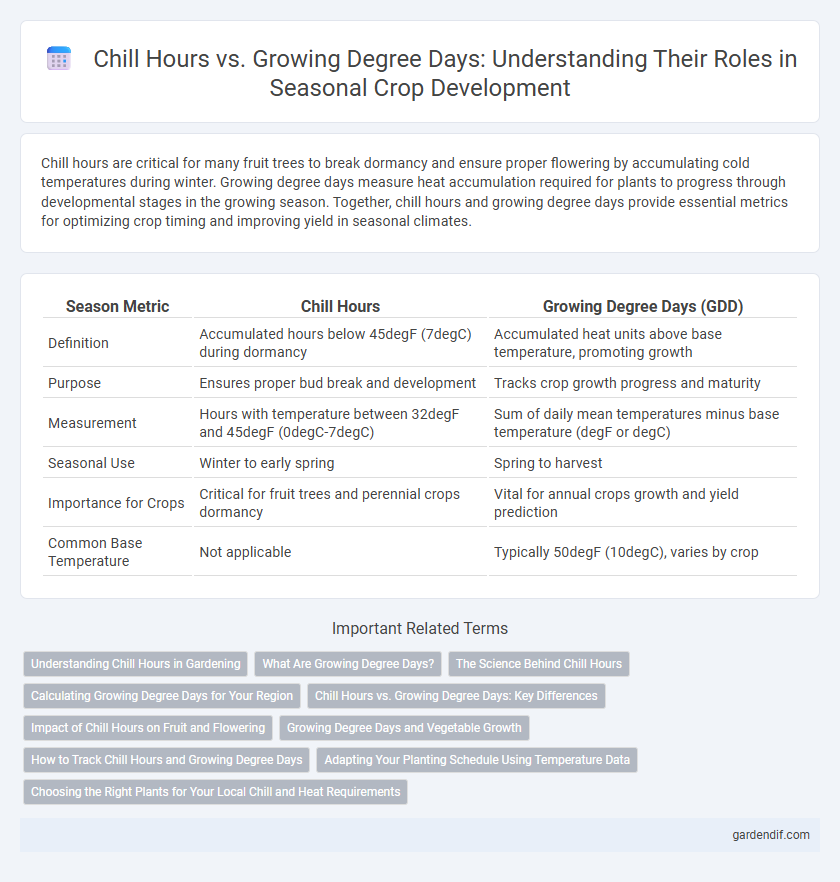
Chill hours vs Growing degree days Illustration
Chill hours are critical for many fruit trees to break dormancy and ensure proper flowering by accumulating cold temperatures during winter. Growing degree days measure heat accumulation required for plants to progress through developmental stages in the growing season. Together, chill hours and growing degree days provide essential metrics for optimizing crop timing and improving yield in seasonal climates.
Table of Comparison
| Season Metric | Chill Hours | Growing Degree Days (GDD) |
|---|---|---|
| Definition | Accumulated hours below 45degF (7degC) during dormancy | Accumulated heat units above base temperature, promoting growth |
| Purpose | Ensures proper bud break and development | Tracks crop growth progress and maturity |
| Measurement | Hours with temperature between 32degF and 45degF (0degC-7degC) | Sum of daily mean temperatures minus base temperature (degF or degC) |
| Seasonal Use | Winter to early spring | Spring to harvest |
| Importance for Crops | Critical for fruit trees and perennial crops dormancy | Vital for annual crops growth and yield prediction |
| Common Base Temperature | Not applicable | Typically 50degF (10degC), varies by crop |
Understanding Chill Hours in Gardening
Chill hours refer to the cumulative number of hours between 32degF and 45degF that plants require during dormancy to break bud and ensure proper flowering and fruit production. This metric is crucial for fruit trees like apples and cherries, as insufficient chill hours can lead to poor yield and delayed bloom. Gardeners use chill hour calculations alongside growing degree days, which track heat accumulation necessary for plant growth, to optimize planting schedules and maximize crop success.
What Are Growing Degree Days?
Growing Degree Days (GDD) measure heat accumulation used to predict plant and insect development rates during a growing season. Calculated by averaging daily maximum and minimum temperatures against a base temperature specific to a crop, GDD provide essential data for optimizing planting and harvesting schedules. Understanding GDD helps farmers manage crop growth efficiently, ensuring better yield and resource use compared to relying solely on chill hours.
The Science Behind Chill Hours
Chill hours represent the cumulative time a plant spends at temperatures between 32degF and 45degF, crucial for breaking dormancy in many fruit and nut trees. This scientific measurement ensures proper bud development by satisfying the plant's chilling requirement during winter months. Accurate calculation of chill hours directly impacts crop yield and quality by aligning plant growth cycles with seasonal temperature variations.
Calculating Growing Degree Days for Your Region
Calculating Growing Degree Days (GDD) involves measuring the accumulated heat units essential for crop development, typically using daily temperature data and base temperature thresholds specific to each plant species. Accurately tracking GDD provides valuable insight into the timing of key growth stages and helps optimize planting and harvest schedules within your region. Unlike chill hours, which quantify cold exposure needed for dormancy break, GDD focuses on active warmth required for growth acceleration.
Chill Hours vs. Growing Degree Days: Key Differences
Chill hours measure the cumulative time temperatures remain between 32degF and 45degF, crucial for breaking dormancy in fruit trees, while Growing Degree Days (GDD) quantify heat accumulation above a base temperature to predict plant development stages. Chill hours ensure proper flowering and fruit set by fulfilling the chilling requirements needed for bud break, whereas GDD helps forecast growth rates and harvest timing. These metrics differ fundamentally in their temperature ranges and applications within seasonal agricultural management, with chill hours focusing on cold exposure and GDD on heat accumulation.
Impact of Chill Hours on Fruit and Flowering
Chill hours are critical for temperate fruit trees, as insufficient chilling delays bud break, reduces flowering, and negatively impacts fruit set and quality. The accumulation of chill hours during winter dormancy ensures synchronized flowering and optimal fruit development, directly influencing yield and crop uniformity. Inadequate chill accumulation disrupts physiological processes, leading to poor fruit yield and inconsistent maturation timing.
Growing Degree Days and Vegetable Growth
Growing Degree Days (GDD) serve as a crucial metric for predicting vegetable growth stages by quantifying heat accumulation necessary for plant development. Unlike chill hours, which measure cold exposure essential for breaking dormancy, GDD directly correlates with the rate of physiological processes, influencing transplant timing and harvest schedules. Accurate GDD calculations help optimize crop yields by aligning planting dates with favorable temperature patterns during the growing season.
How to Track Chill Hours and Growing Degree Days
Tracking chill hours involves measuring the cumulative number of hours temperatures stay between 32degF and 45degF during dormancy to evaluate winter cold exposure essential for fruit tree development. Growing Degree Days (GDD) are calculated by averaging daily maximum and minimum temperatures above a base threshold, often 50degF, to estimate heat accumulation driving plant growth. Utilize agricultural weather stations, specialized apps, or online tools to monitor and record these temperature metrics for precise season management and optimized crop production.
Adapting Your Planting Schedule Using Temperature Data
Tracking chill hours and growing degree days provides critical insights for optimizing planting schedules by aligning crop development with seasonal temperature patterns. Chill hours quantify the cumulative cold exposure necessary for certain fruit trees to break dormancy, while growing degree days measure heat accumulation to predict plant growth stages. Utilizing local temperature data to balance these metrics helps farmers adapt planting times, improve crop yield, and manage risk from climatic variability.
Choosing the Right Plants for Your Local Chill and Heat Requirements
Choosing plants with appropriate chill hour and growing degree day requirements ensures optimal growth and fruit production in your local climate. Chill hours measure the cold exposure needed to break dormancy, vital for temperate fruit trees, while growing degree days track heat accumulation essential for flowering and fruit ripening. Matching these factors to your region's seasonal temperature patterns maximizes yield and plant health.
Chill hours vs Growing degree days Infographic

 gardendif.com
gardendif.com